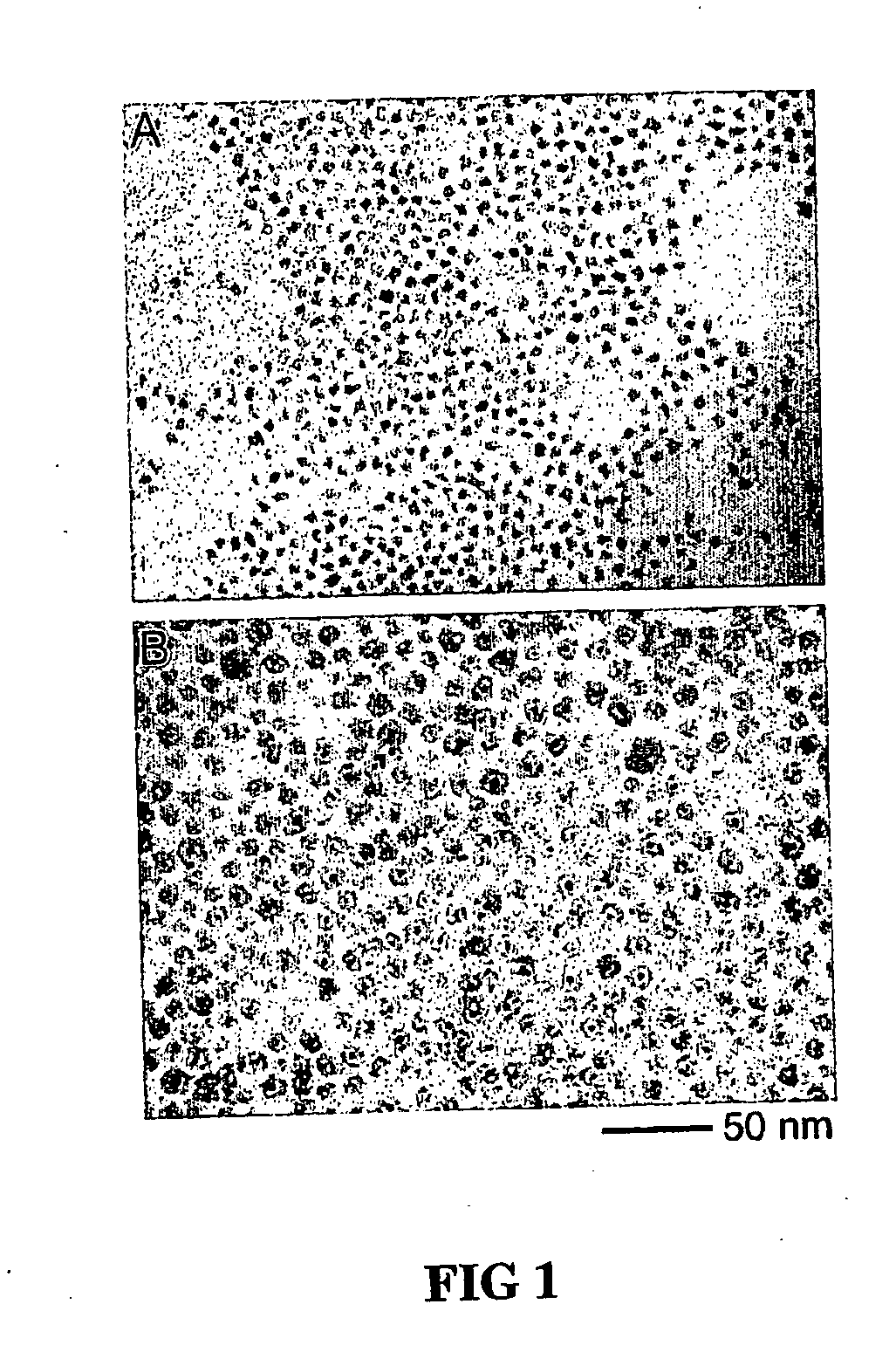Nanoreactors and Method of Making
- Summary
- Abstract
- Description
- Claims
- Application Information
AI Technical Summary
Problems solved by technology
Method used
Image
Examples
example 1
Synthesis of Pt@Co9S8 Nanoreactors
[0044]Pt was provided by preparing platinum nanoparticles by injecting a solution of 0.15 g of platinum acetylacetonate in 5 ml of o-dichlorobenzene into a refluxing bath of 10 ml of o-dichlorobenzene containing 0.3 g of 1,2-hexadecanediol, 0.1 ml of oleic acid, 0.1 ml of oleylamine and 0.06 ml of trioctylphosphine. The solution was then heated for another 120 minutes to yield Pt nanoparticles in solution. Pt@Co9S8 nanoreactors are formed by injecting 1.08 g Co2(CO)8 in 6 ml o-dichlorobenzene into the platinum nanocrystal solution followed by the sulfidation of the product particles by injecting a solution of 0.171 g sulfur in 10 ml of o-dichlorobenzene. The system was kept at the same temperature under stirring for 3 minutes. A black stable colloidal dispersion in o-dichlorobenzene is obtained. Finally, the Pt@Co9S8 nanoreactors are precipitated by methanol, washed with toluene and methanol three times, and dried under vacuum. Nitrogen adsorption / d...
example 2
Synthesis of Pt@Co3S4 Nanoreactors
[0045]Platinum nanoparticles are prepared by injecting a solution of 0.15 g of platinum acetylacetonate in 5 ml of o-dichlorobenzene into a refluxing bath of 10 ml of o-dichlorobenzene containing 0.3 g of 1,2-hexadecanediol, 0.1 ml of oleic acid, 0.1 ml of oleylamine and 0.06 ml of trioctylphosphine. The solution was then heated for another 120 minutes. Pt@Co3S4 nanostructures are formed by injecting 1.08 g Co2(CO)8 in 6 ml o-dichlorobenzene into the platinum nanoparticle solution followed by the sulfidation of the product particles by injecting a solution of 0.256 g sulfur in 10 ml of o-dichlorobenzene. The system was kept at the same temperature under stirring for 3 minutes. A black stable colloidal dispersion in o-dichlorobenzene is obtained. Finally, the Pt@Co3S4 particles are precipitated by methanol, washed with toluene and methanol three times, and dried under vacuum. Nitrogen adsorption / desorption measurement on the powder at 77K shows a typ...
example 3
Synthesis of Pt@CoO Nanoreactors
[0046]Platinum nanoparticles are prepared by injecting a solution of 0.15 g of platinum acetylacetonate in 5 ml of o-dichlorobenzene into a refluxing bath of 10 ml of o-dichlorobenzene containing 0.3 g of 1,2-hexadecanediol, 0.1 ml of oleic acid, 0.1 ml of oleylamine and 0.06 ml of trioctylphosphine. The solution was then heated for another 120 minutes. Pt@CoO nanostructures formed by injecting 1.08 g Co2(CO)8 in 6 ml o-dichlorobenzene into the platinum nanocrystals solution, and followed by the oxidation of the product particles by blowing a stream of O2 / Ar (1:4 in volume ratio, 120 ml / min) mixture into the colloidal solution at 455 K. The system was kept at the same temperature under stirring for 3 hours. A black stable colloidal dispersion in o-dichlorobenzene is obtained. Finally, the Pt@CoO nanoreactors are precipitated by methanol, washed with toluene and methanol three times, and dried under vacuum. Typical nitrogen adsorption / desorption measur...
PUM
| Property | Measurement | Unit |
|---|---|---|
| Length | aaaaa | aaaaa |
| Length | aaaaa | aaaaa |
| Thickness | aaaaa | aaaaa |
Abstract
Description
Claims
Application Information
 Login to View More
Login to View More - R&D
- Intellectual Property
- Life Sciences
- Materials
- Tech Scout
- Unparalleled Data Quality
- Higher Quality Content
- 60% Fewer Hallucinations
Browse by: Latest US Patents, China's latest patents, Technical Efficacy Thesaurus, Application Domain, Technology Topic, Popular Technical Reports.
© 2025 PatSnap. All rights reserved.Legal|Privacy policy|Modern Slavery Act Transparency Statement|Sitemap|About US| Contact US: help@patsnap.com


